
x-lstm
Pytorch implementation of the xLSTM model by Beck et al. (2024)
Stars: 91
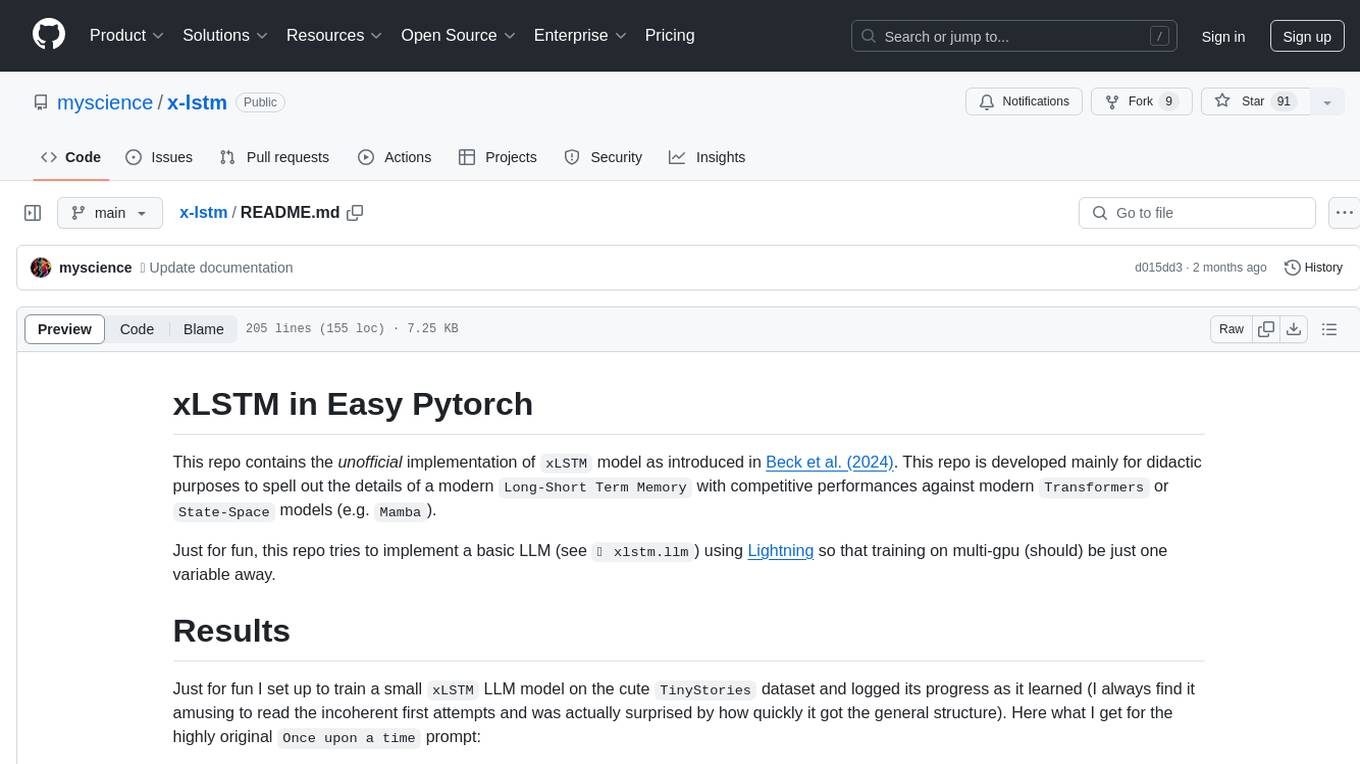
This repository contains an unofficial implementation of the xLSTM model introduced in Beck et al. (2024). It serves as a didactic tool to explain the details of a modern Long-Short Term Memory model with competitive performance against Transformers or State-Space models. The repository also includes a Lightning-based implementation of a basic LLM for multi-GPU training. It provides modules for scalar-LSTM and matrix-LSTM, as well as an xLSTM LLM built using Pytorch Lightning for easy training on multi-GPUs.
README:
This repo contains the unofficial implementation of xLSTM model as introduced in Beck et al. (2024). This repo is developed mainly for didactic purposes to spell out the details of a modern Long-Short Term Memory with competitive performances against modern Transformers or State-Space models (e.g. Mamba).
Just for fun, this repo tries to implement a basic LLM (see 📂 xlstm.llm) using Lightning so that training on multi-gpu (should) be just one variable away.
Just for fun I set up to train a small xLSTM LLM model on the cute TinyStories dataset and logged its progress as it learned (I always find it amusing to read the incoherent first attempts and was actually surprised by how quickly it got the general structure). Here what I get for the highly original Once upon a time prompt:
At initialization
Once upon a timeboro wit carryingabellaastered Greens intestinal Pil su128 configure Patentrowing SeventhNohs implies Burger ® Cities lowacommTYelligimilationbender Manual authored Comprehensivelow fightingrinasq intercourse377 gradientafe bluntlyaroo coats Witchhiba Jeff Flags ambassadors iT deleted Deals reassCruzka...(you get the idea)
After 320 steps
Once upon a time. She and took them. He is and they with something. She asked, a big dog on the park. Lily went to the park, ''That wanted it is not she is
verv hanov into the around's mom man was a lot him to the "Thank
he couldn't sad and. He is a time. "What and not to go be careful. She was that the little girl, I will. Then it?''' Tom things. He took it they saw a bia."
After 20K steps
Once upon a time. Jack and ran across the hill. When she always a bit embarrassed and felt so much to play!" And they couldn't know what you should always made of the park." One day she wanted to help make some new friends."
"The boy was so happy to a time.
"Lily's help. He was very sorry, there. Then, and it looked at how he saw the ball. When she was happy and had so excited to buy the ground. He used to fly was very happy and daddy was so excited and the car. Timmy went to go home."
The xlstm module exposes both the sLSTM (scalar-LSTM) and the mLSTM (matrix-LSTM) modules. Both expect their input to have shape (batch_size, d_input) as they consume an input sequence sequentially. They output the model current (projected) hidden state h_t (which is considered the module output and has the same shape as the input, see Figure 9 in the Appendix of Beck et al. (2024)), plus their updated hidden variables (a tuple of tensors).
from xlstm import sLSTM
from itertools import pairwise
seq_len = 32
batch_size = 4
inp_dim = 16
head_dim = 8
head_num = 4
# Create a mock up input sequence
seq = torch.randn(seq_len, batch_size, inp_dim)
lstm = sLSTM(
inp_dim, # Input sequence dimension
head_dim, # Dimension of each head
head_num, # Number of heads
p_factor=4/3, # Tunable expansion factor
)
# Initialize the hidden states
hid = lstm.init_hidden(batch_size)
criterion = ... # Pick some loss function, i.e. MSE
# Iterate through the sequence length
loss = 0
for prev, succ in pairwise(seq):
# Get the model prediction plus the updated hidden states
pred, hid = lstm(prev, hid)
# Target is the next sequence token
loss += criterion(pred, succ)
# Compute gradients
loss.backward()This repo also provides an implementation of an xLSTM LLM (which is simply a stack of sLSTMs and mLSTM plus a prediction head) built using Pytorch Lightning which unlocks easy training on multi-gpus. To use it one can simply run the following example:
from lightning import Trainer
from transformers import AutoTokenizer
from xlstm import xLSTM
from xlstm.stories import TinyStoriesLightning
config = ... # path to YAML configuration file
# Load an off-the-shelf tokenizer from HF
tokenizer = AutoTokenizer.from_pretrained('openai-community/gpt2')
# Load the Mamba model from a config file
model = xLSTM.from_config(config, key='llm')
# Load the dataset
dataset = TinyStoriesLightning.from_config(
config,
tokenizer,
key='dataset'
)
trainer = Trainer(
max_epochs = 500,
accelerator = 'gpu',
devices = 4, # Piece of cake multi-gpu support!
strategy = 'ddp_find_unused_parameters_false',
)
# Train the model
trainer.fit(model, dataset)Alternatively, one can also run the training script run.py directly which leverages the LightningCLI API which offers great flexibility for customization. The script expects a configuration file path (see example configuration file in 📂 config/llm.yaml) and accepts all the Trainer arguments (and more! See LightningCLI for reference).
python run.py fit --config config/llm.yamlA cool feature of xLSTM current implementation is the lazy (batched-) inference implemented via a generator. One can thus print tokens on screen as they are streamed by the model, no need to wait for the whole inference to finish! A mock-up script would look like the following.
from xlstm import xLSTM
from transformers import AutoTokenizer
# Get an off-the-shelf tokenizer
tokenizer = AutoTokenizer.from_pretrained('openai-community/gpt2')
tokenizer.add_special_tokens({'pad_token': '<|pad|>'})
# Parameters for the LLM
vocab_size = tokenizer.vocab_size + 1
num_layers = 8
signature = (7, 1)
inp_dim = 16
head_dim = 8
head_num = 4
ker_size = 4
p_factor = (2, 4/3)
model = xLSTM(
vocab_size = vocab_size,
num_layers = self.num_layers,
signature = self.signature,
inp_dim= self.inp_dim,
head_dim= self.head_dim,
head_num= self.head_num,
p_factor= self.p_factor,
ker_size = self.ker_size,
)
# Parameters for the inference
token_lim = 16
use_top_k = 50
temperature = 0.7
# Generate text
stream = model.generate(
# We can provide more than one prompt!
prompt=[
'Once upon a time',
'In a galaxy far far away',
],
tokenizer=tokenizer,
token_lim=token_lim,
use_top_k=use_top_k,
temperature=temperature,
)
for token in stream:
# Each token is a dictionary indexed by the
# batch-id and contains the produced string
# as value, so we can print the first batch as:
print(token[0], end='')- [x] Put all the essential pieces together (i.e.
sLSTM&mLSTM) - [x] Add implementation for a full
xLSTM - [x] Add functioning training script (Lightning)
- [x] Show some results
Code was tested with Python 3.11+. To install the required dependencies simply run pip install -r requirements.txt.
torch==2.3.0
PyYAML==6.0.1
einops==0.8.0
lightning==2.2.4
setuptools==69.5.1
transformers==4.40.2
@article{beck2024xlstm,
title={xLSTM: Extended Long Short-Term Memory},
author={Beck, Maximilian and P{\"o}ppel, Korbinian and Spanring, Markus and Auer, Andreas and Prudnikova, Oleksandra and Kopp, Michael and Klambauer, G{\"u}nter and Brandstetter, Johannes and Hochreiter, Sepp},
journal={arXiv preprint arXiv:2405.04517},
year={2024}
}For Tasks:
Click tags to check more tools for each tasksFor Jobs:
Alternative AI tools for x-lstm
Similar Open Source Tools

x-lstm
This repository contains an unofficial implementation of the xLSTM model introduced in Beck et al. (2024). It serves as a didactic tool to explain the details of a modern Long-Short Term Memory model with competitive performance against Transformers or State-Space models. The repository also includes a Lightning-based implementation of a basic LLM for multi-GPU training. It provides modules for scalar-LSTM and matrix-LSTM, as well as an xLSTM LLM built using Pytorch Lightning for easy training on multi-GPUs.
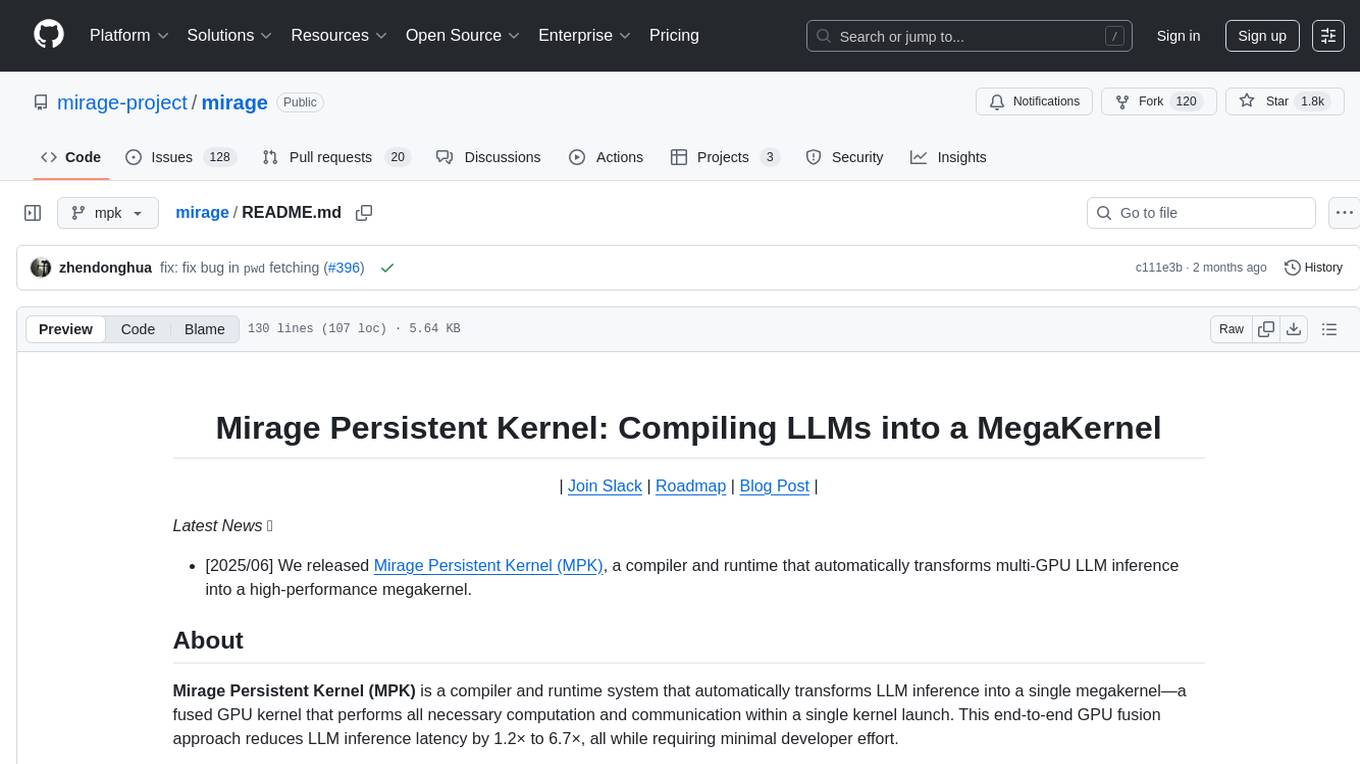
mirage
Mirage Persistent Kernel (MPK) is a compiler and runtime system that automatically transforms LLM inference into a single megakernel—a fused GPU kernel that performs all necessary computation and communication within a single kernel launch. This end-to-end GPU fusion approach reduces LLM inference latency by 1.2× to 6.7×, all while requiring minimal developer effort.
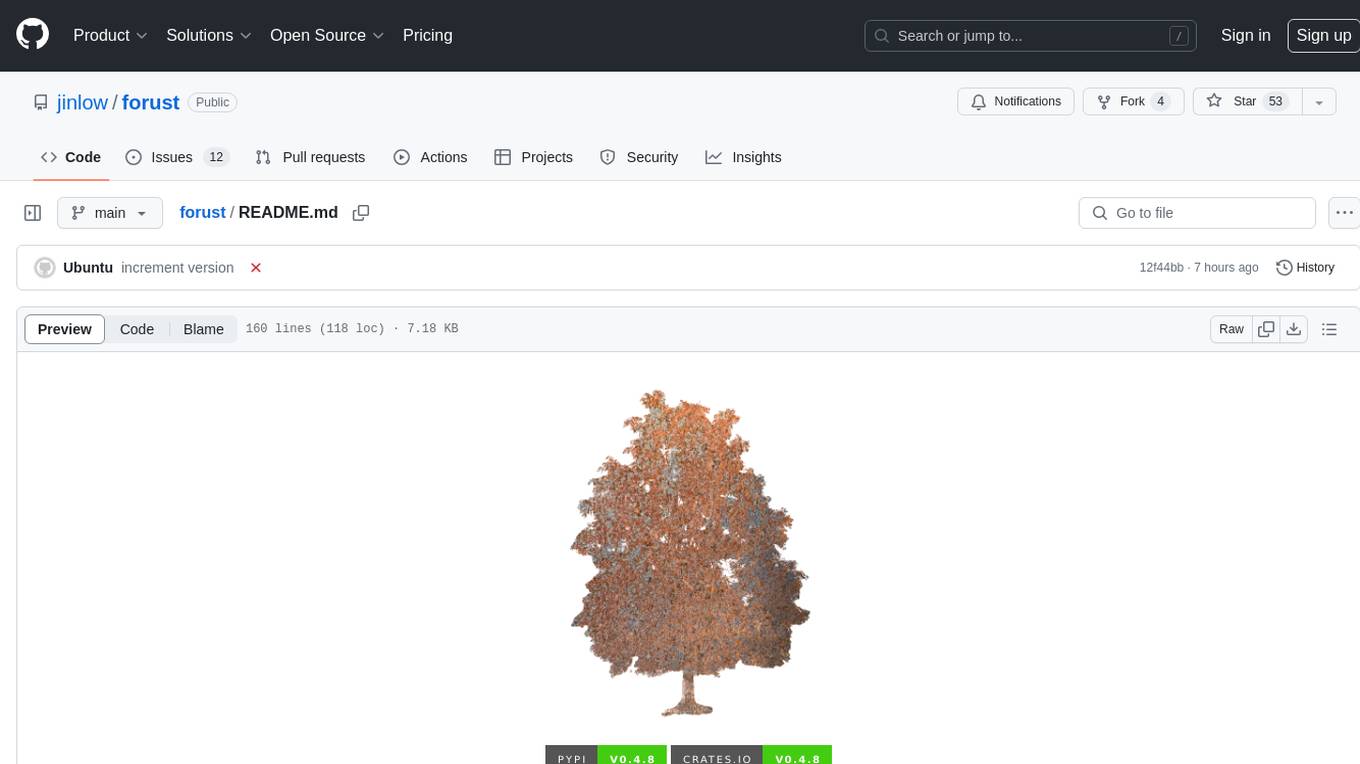
forust
Forust is a lightweight package for building gradient boosted decision tree ensembles. The algorithm code is written in Rust with a Python wrapper. It implements the same algorithm as XGBoost and provides nearly identical results. The package was developed to better understand XGBoost, as a fun project in Rust, and to experiment with adding new features to the algorithm in a simpler codebase. Forust allows training gradient boosted decision tree ensembles with multiple objective functions, predicting on datasets, inspecting model structures, calculating feature importance, and saving/loading trained boosters.
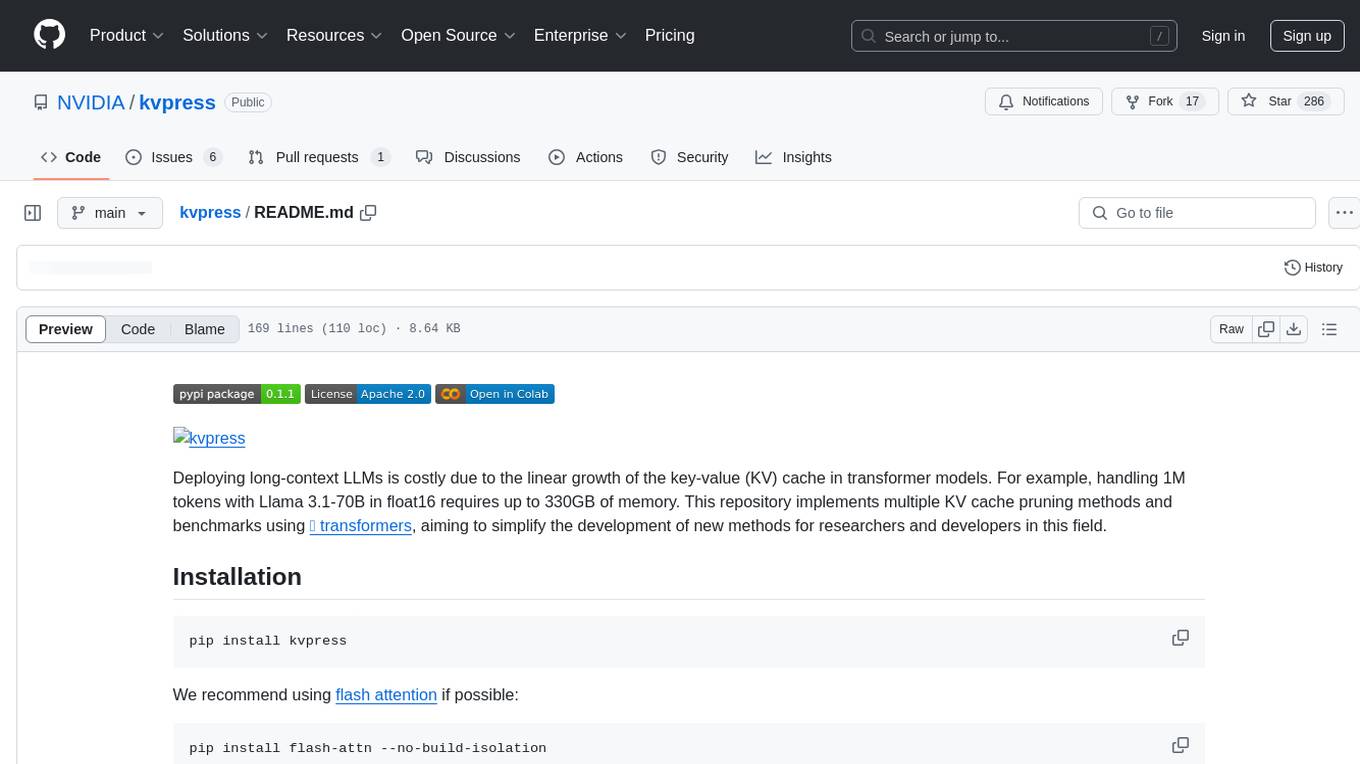
kvpress
This repository implements multiple key-value cache pruning methods and benchmarks using transformers, aiming to simplify the development of new methods for researchers and developers in the field of long-context language models. It provides a set of 'presses' that compress the cache during the pre-filling phase, with each press having a compression ratio attribute. The repository includes various training-free presses, special presses, and supports KV cache quantization. Users can contribute new presses and evaluate the performance of different presses on long-context datasets.
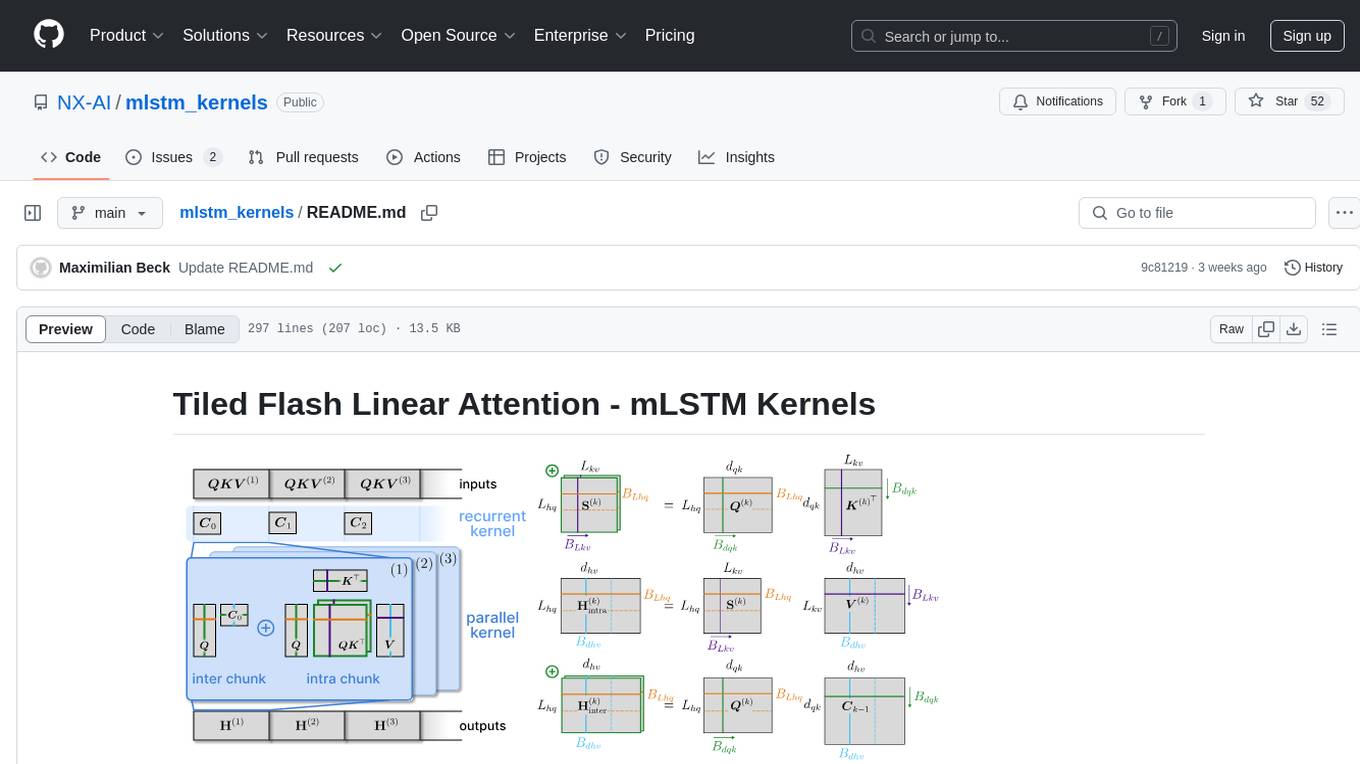
mlstm_kernels
This repository provides fast and efficient mLSTM training and inference Triton kernels built on Tiled Flash Linear Attention (TFLA). It includes implementations in JAX, PyTorch, and Triton, with chunkwise, parallel, and recurrent kernels for mLSTM. The repository also contains a benchmark library for runtime benchmarks and full mLSTM Huggingface models.
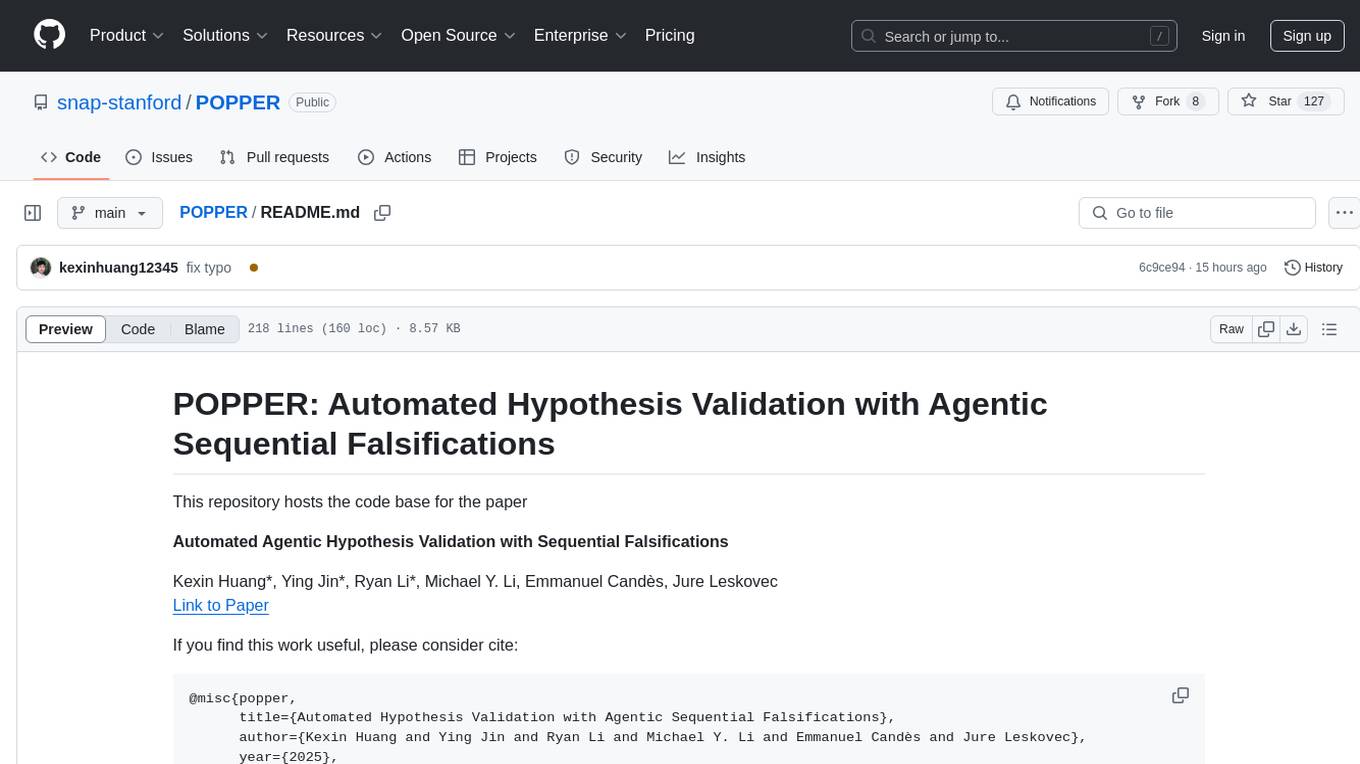
POPPER
Popper is an agentic framework for automated validation of free-form hypotheses using Large Language Models (LLMs). It follows Karl Popper's principle of falsification and designs falsification experiments to validate hypotheses. Popper ensures strict Type-I error control and actively gathers evidence from diverse observations. It delivers robust error control, high power, and scalability across various domains like biology, economics, and sociology. Compared to human scientists, Popper achieves comparable performance in validating complex biological hypotheses while reducing time by 10 folds, providing a scalable, rigorous solution for hypothesis validation.
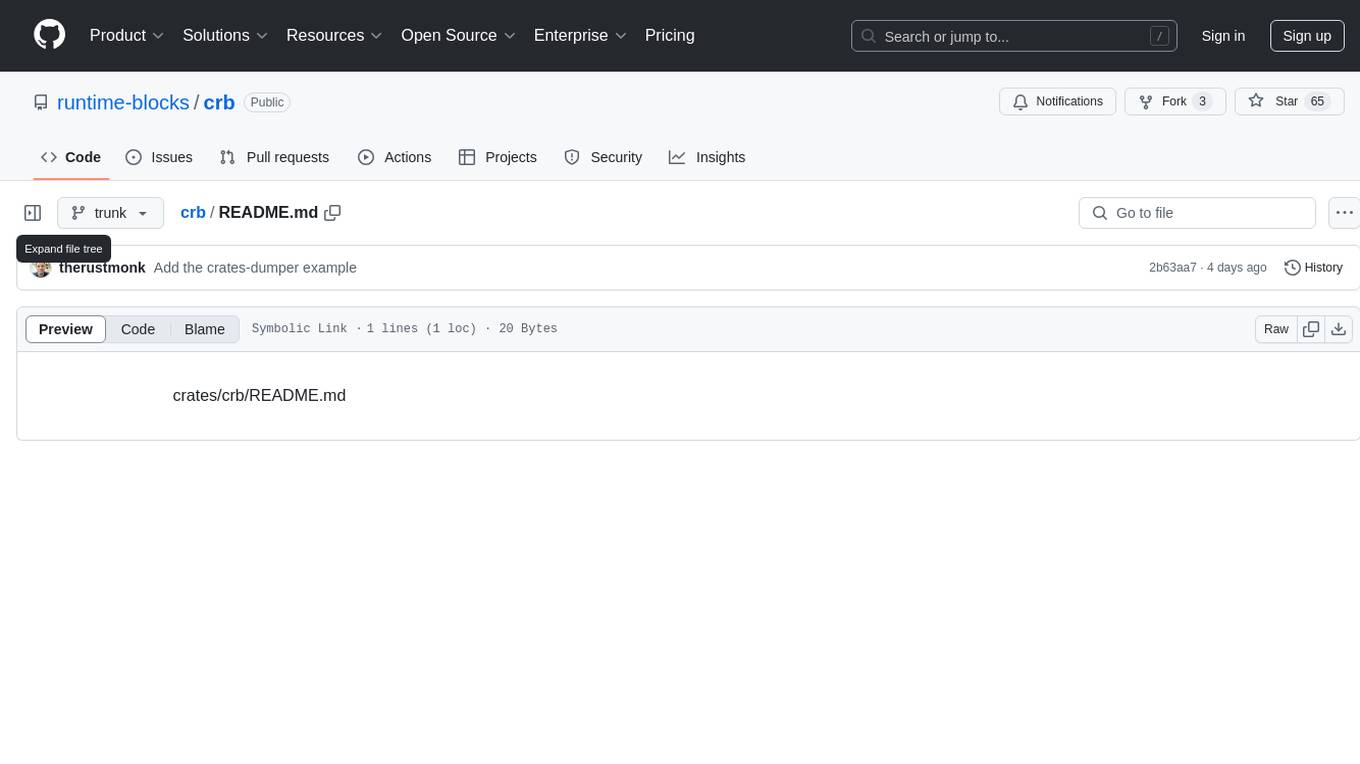
crb
CRB (Composable Runtime Blocks) is a unique framework that implements hybrid workloads by seamlessly combining synchronous and asynchronous activities, state machines, routines, the actor model, and supervisors. It is ideal for building massive applications and serves as a low-level framework for creating custom frameworks, such as AI-agents. The core idea is to ensure high compatibility among all blocks, enabling significant code reuse. The framework allows for the implementation of algorithms with complex branching, making it suitable for building large-scale applications or implementing complex workflows, such as AI pipelines. It provides flexibility in defining structures, implementing traits, and managing execution flow, allowing users to create robust and nonlinear algorithms easily.
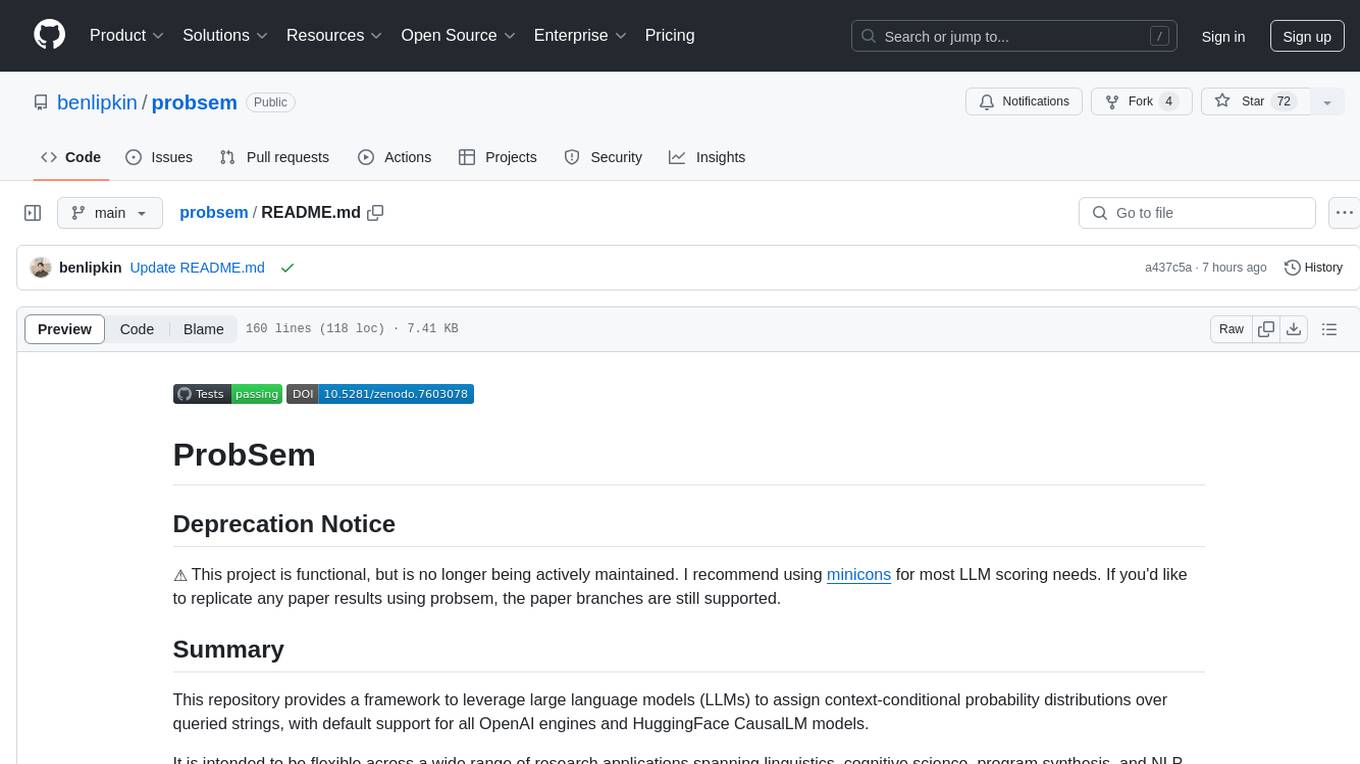
probsem
ProbSem is a repository that provides a framework to leverage large language models (LLMs) for assigning context-conditional probability distributions over queried strings. It supports OpenAI engines and HuggingFace CausalLM models, and is flexible for research applications in linguistics, cognitive science, program synthesis, and NLP. Users can define prompts, contexts, and queries to derive probability distributions over possible completions, enabling tasks like cloze completion, multiple-choice QA, semantic parsing, and code completion. The repository offers CLI and API interfaces for evaluation, with options to customize models, normalize scores, and adjust temperature for probability distributions.
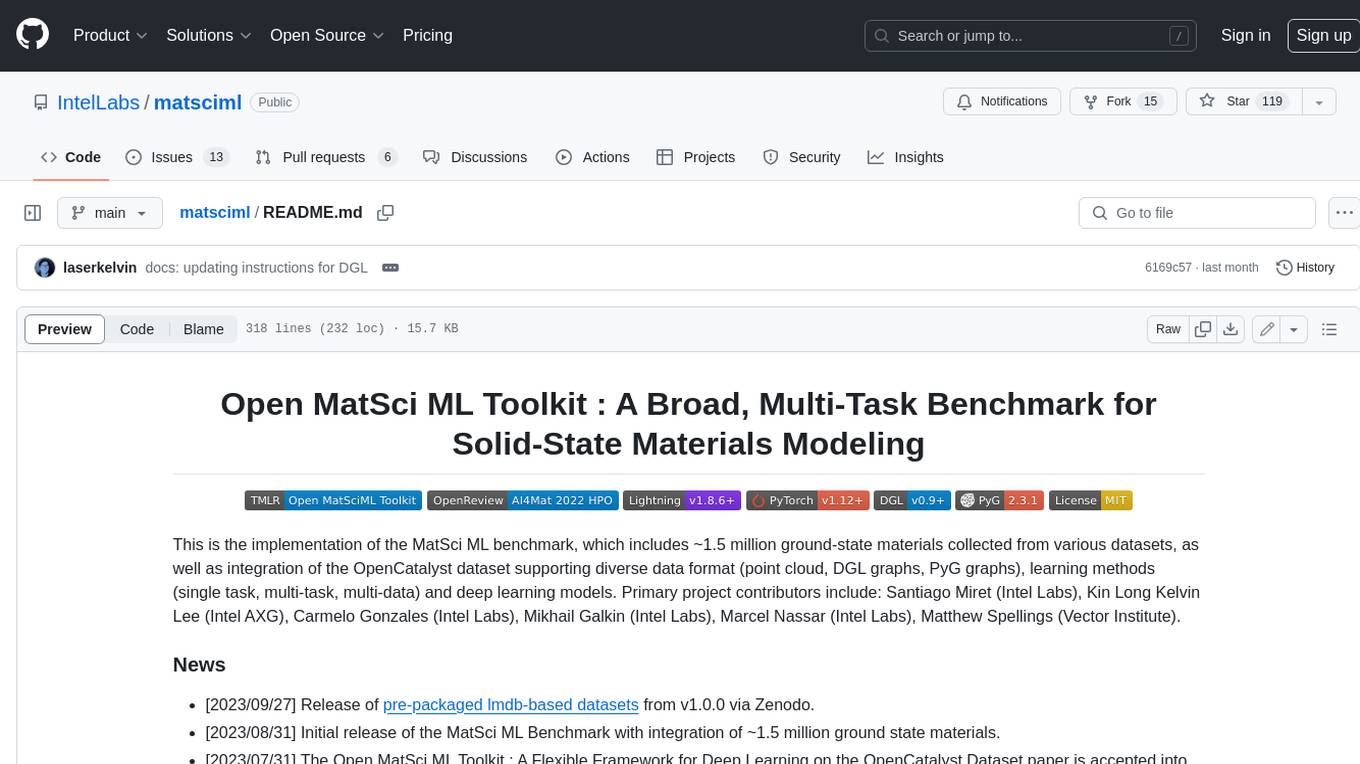
matsciml
The Open MatSci ML Toolkit is a flexible framework for machine learning in materials science. It provides a unified interface to a variety of materials science datasets, as well as a set of tools for data preprocessing, model training, and evaluation. The toolkit is designed to be easy to use for both beginners and experienced researchers, and it can be used to train models for a wide range of tasks, including property prediction, materials discovery, and materials design.
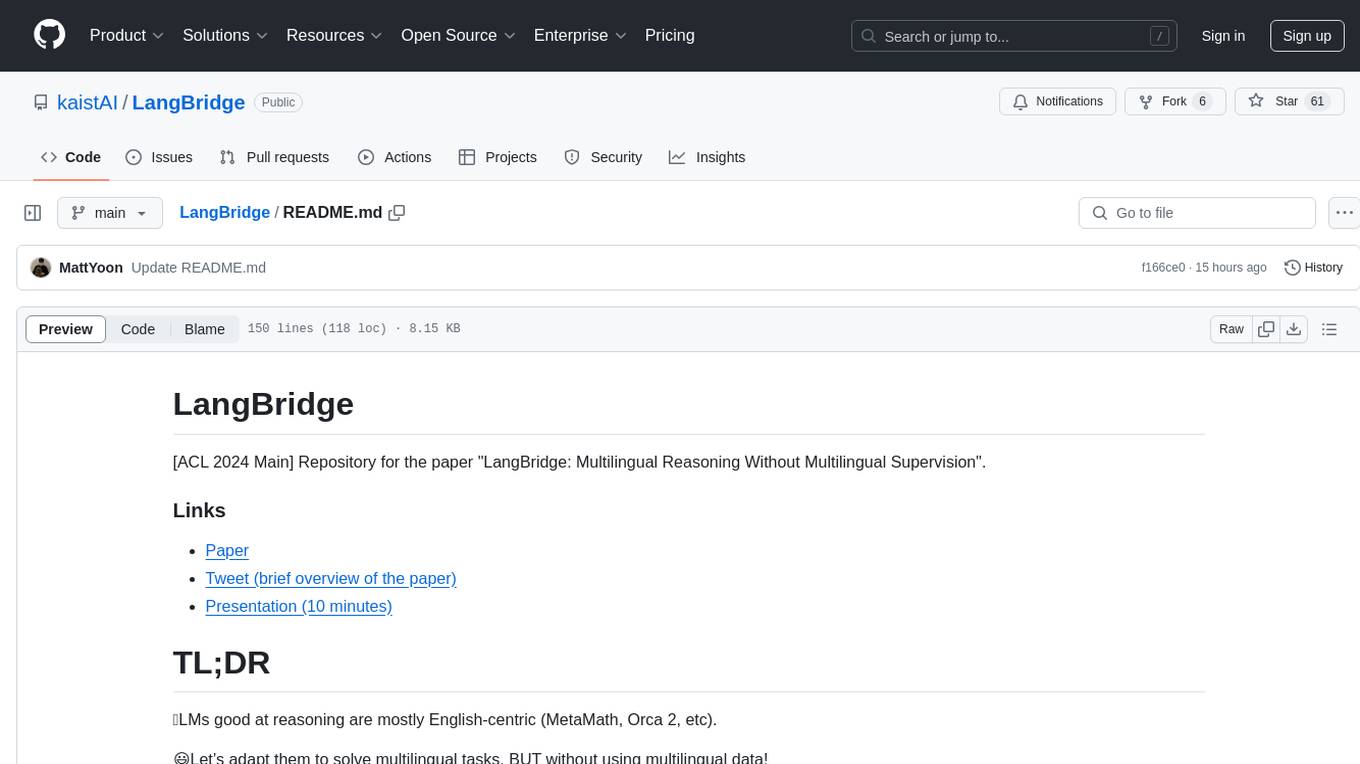
LangBridge
LangBridge is a tool that bridges mT5 encoder and the target LM together using only English data. It enables models to effectively solve multilingual reasoning tasks without the need for multilingual supervision. The tool provides pretrained models like Orca 2, MetaMath, Code Llama, Llemma, and Llama 2 for various instruction-tuned and not instruction-tuned scenarios. Users can install the tool to replicate evaluations from the paper and utilize the models for multilingual reasoning tasks. LangBridge is particularly useful for low-resource languages and may lower performance in languages where the language model is already proficient.
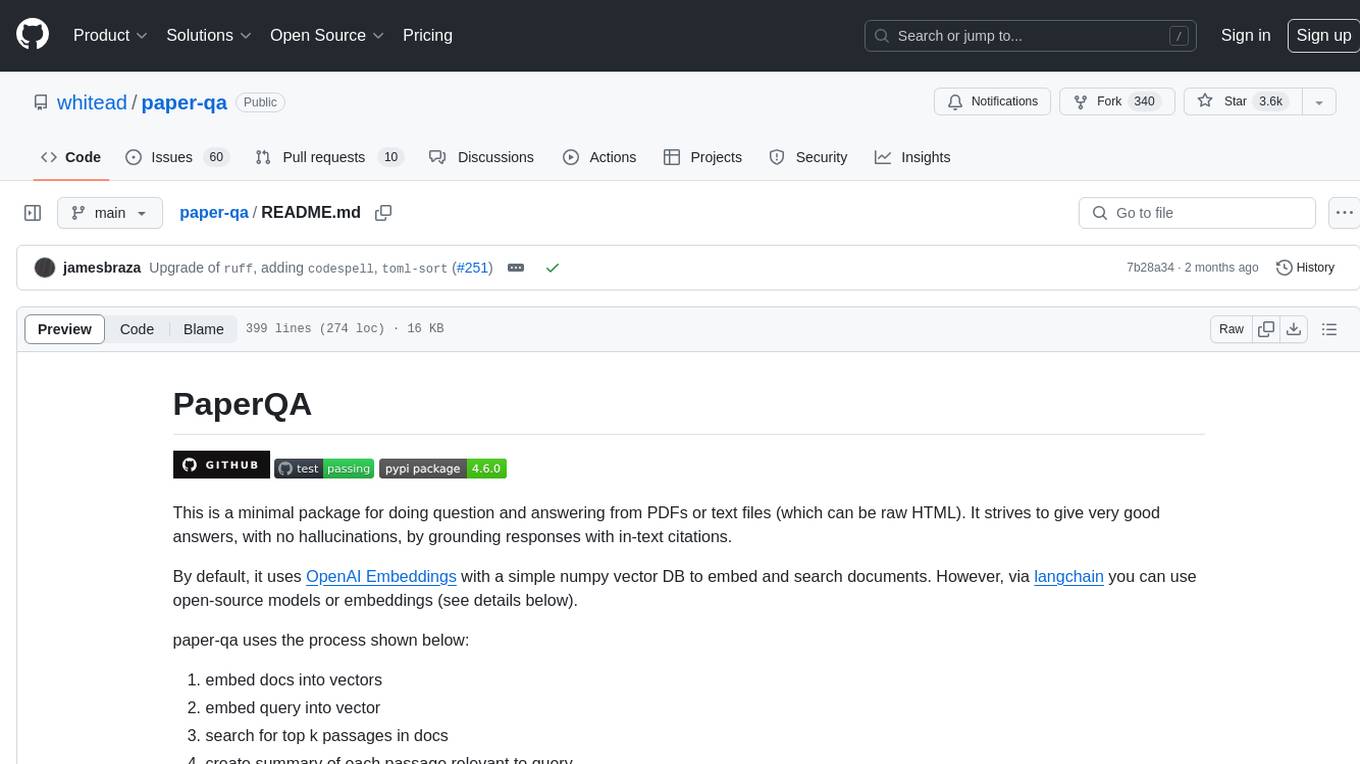
paper-qa
PaperQA is a minimal package for question and answering from PDFs or text files, providing very good answers with in-text citations. It uses OpenAI Embeddings to embed and search documents, and follows a process of embedding docs and queries, searching for top passages, creating summaries, scoring and selecting relevant summaries, putting summaries into prompt, and generating answers. Users can customize prompts and use various models for embeddings and LLMs. The tool can be used asynchronously and supports adding documents from paths, files, or URLs.
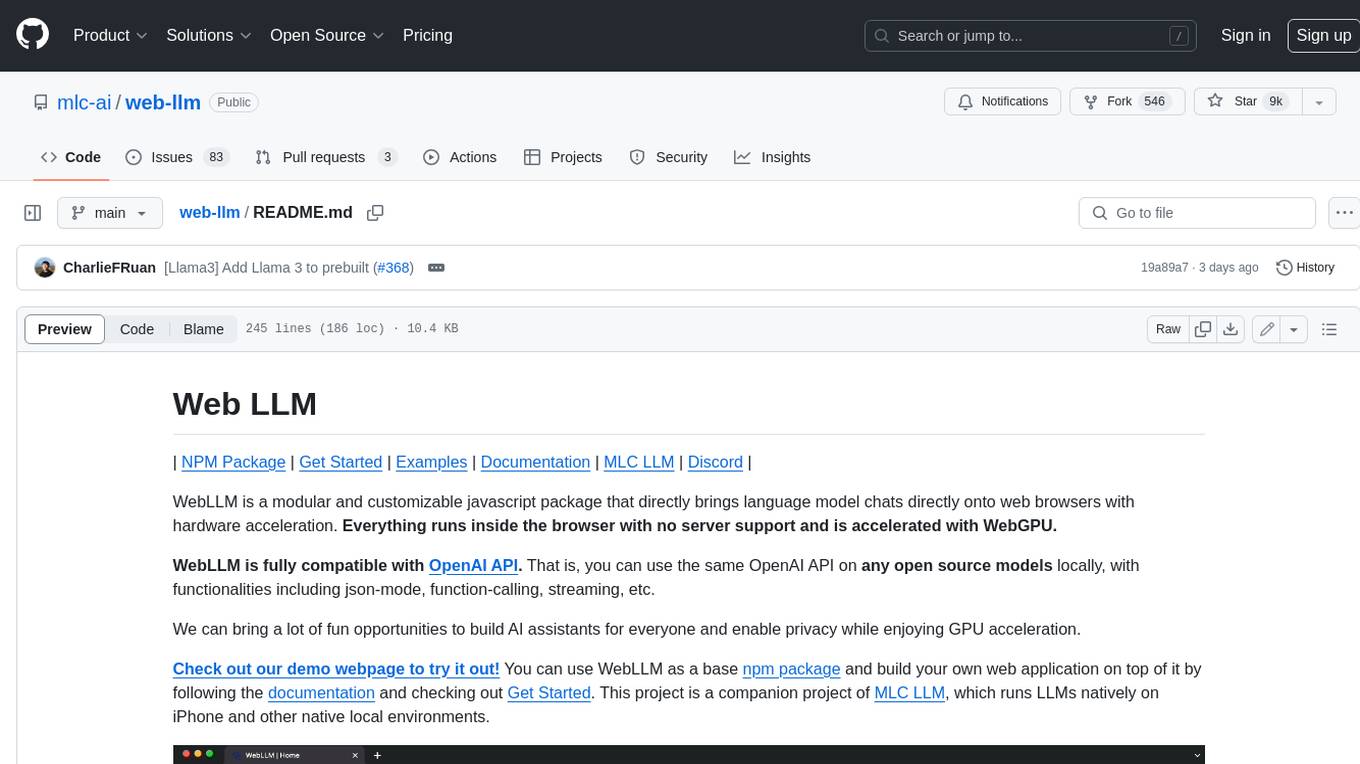
web-llm
WebLLM is a modular and customizable javascript package that directly brings language model chats directly onto web browsers with hardware acceleration. Everything runs inside the browser with no server support and is accelerated with WebGPU. WebLLM is fully compatible with OpenAI API. That is, you can use the same OpenAI API on any open source models locally, with functionalities including json-mode, function-calling, streaming, etc. We can bring a lot of fun opportunities to build AI assistants for everyone and enable privacy while enjoying GPU acceleration.
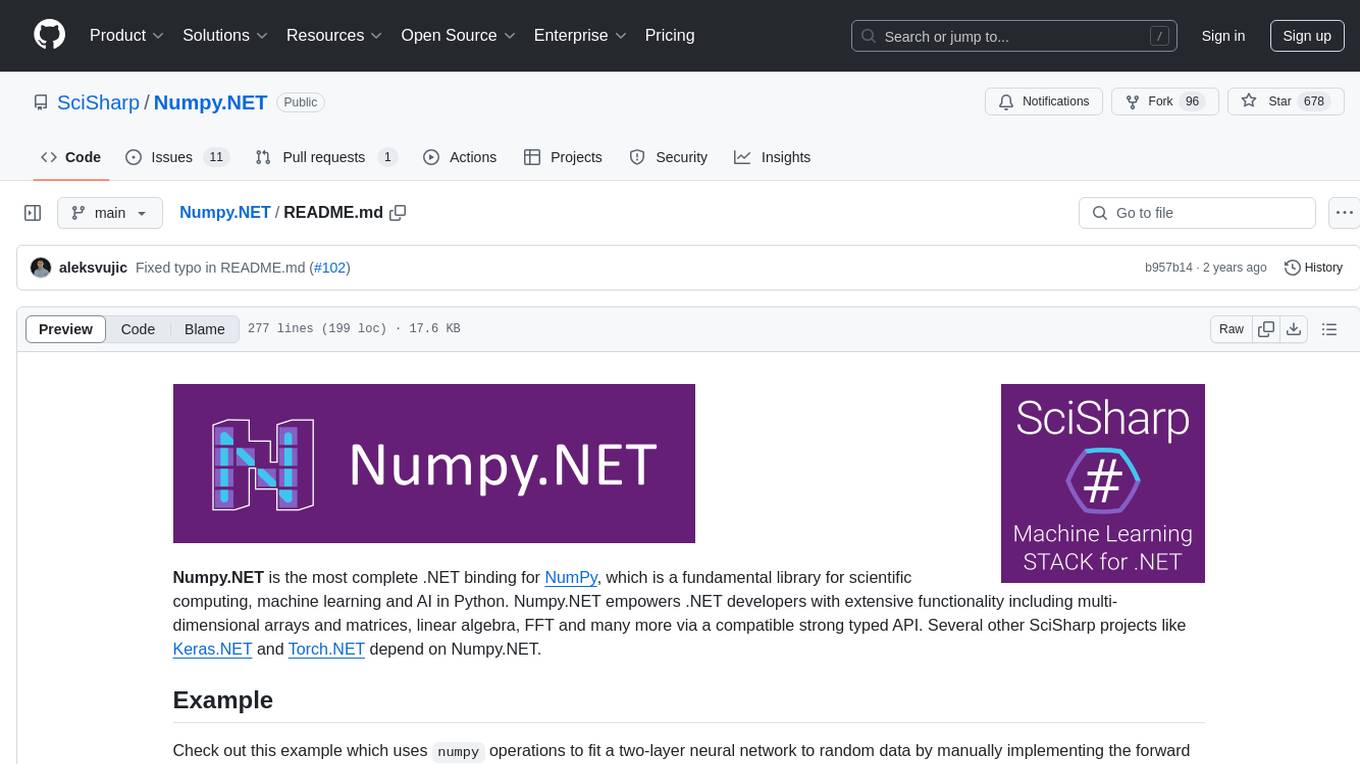
Numpy.NET
Numpy.NET is the most complete .NET binding for NumPy, empowering .NET developers with extensive functionality for scientific computing, machine learning, and AI. It provides multi-dimensional arrays, matrices, linear algebra, FFT, and more via a strong typed API. Numpy.NET does not require a local Python installation, as it uses Python.Included to package embedded Python 3.7. Multi-threading must be handled carefully to avoid deadlocks or access violation exceptions. Performance considerations include overhead when calling NumPy from C# and the efficiency of data transfer between C# and Python. Numpy.NET aims to match the completeness of the original NumPy library and is generated using CodeMinion by parsing the NumPy documentation. The project is MIT licensed and supported by JetBrains.
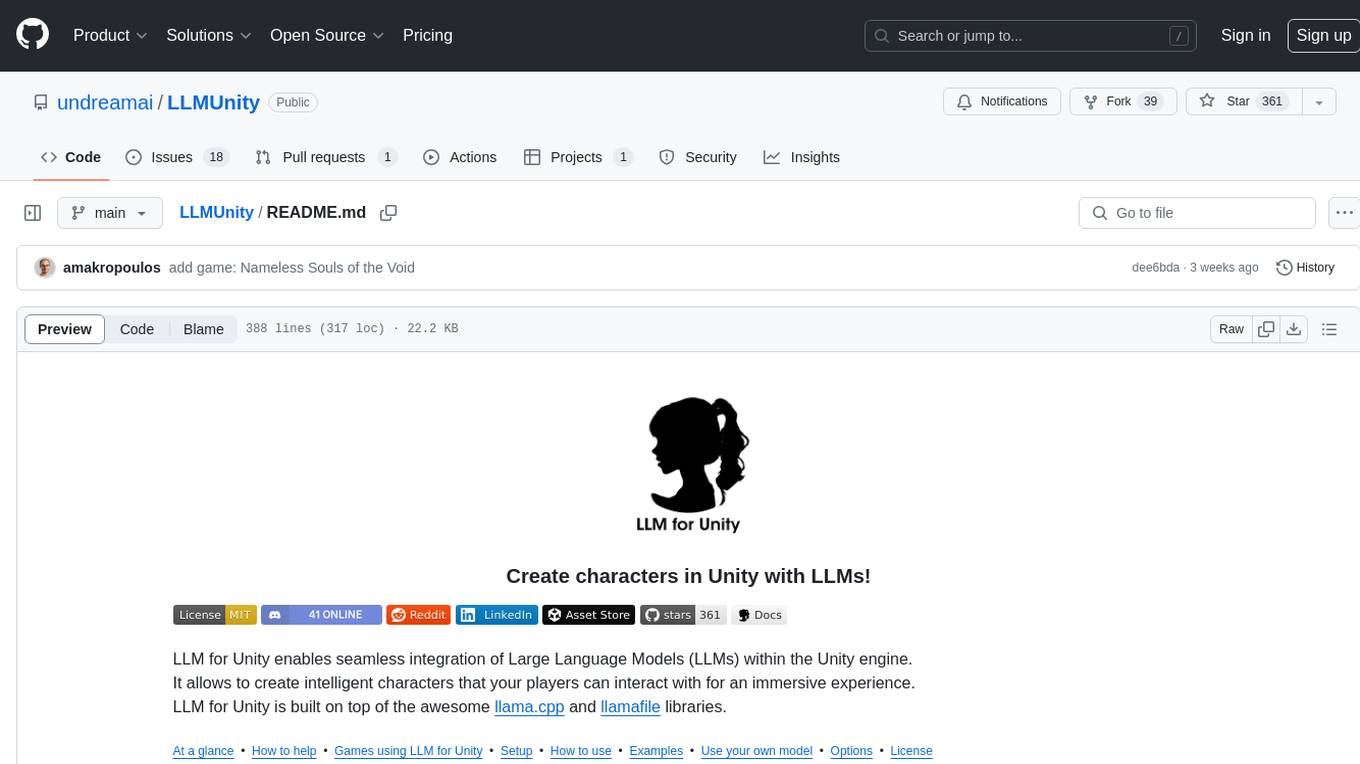
LLMUnity
LLM for Unity enables seamless integration of Large Language Models (LLMs) within the Unity engine, allowing users to create intelligent characters for immersive player interactions. The tool supports major LLM models, runs locally without internet access, offers fast inference on CPU and GPU, and is easy to set up with a single line of code. It is free for both personal and commercial use, tested on Unity 2021 LTS, 2022 LTS, and 2023. Users can build multiple AI characters efficiently, use remote servers for processing, and customize model settings for text generation.
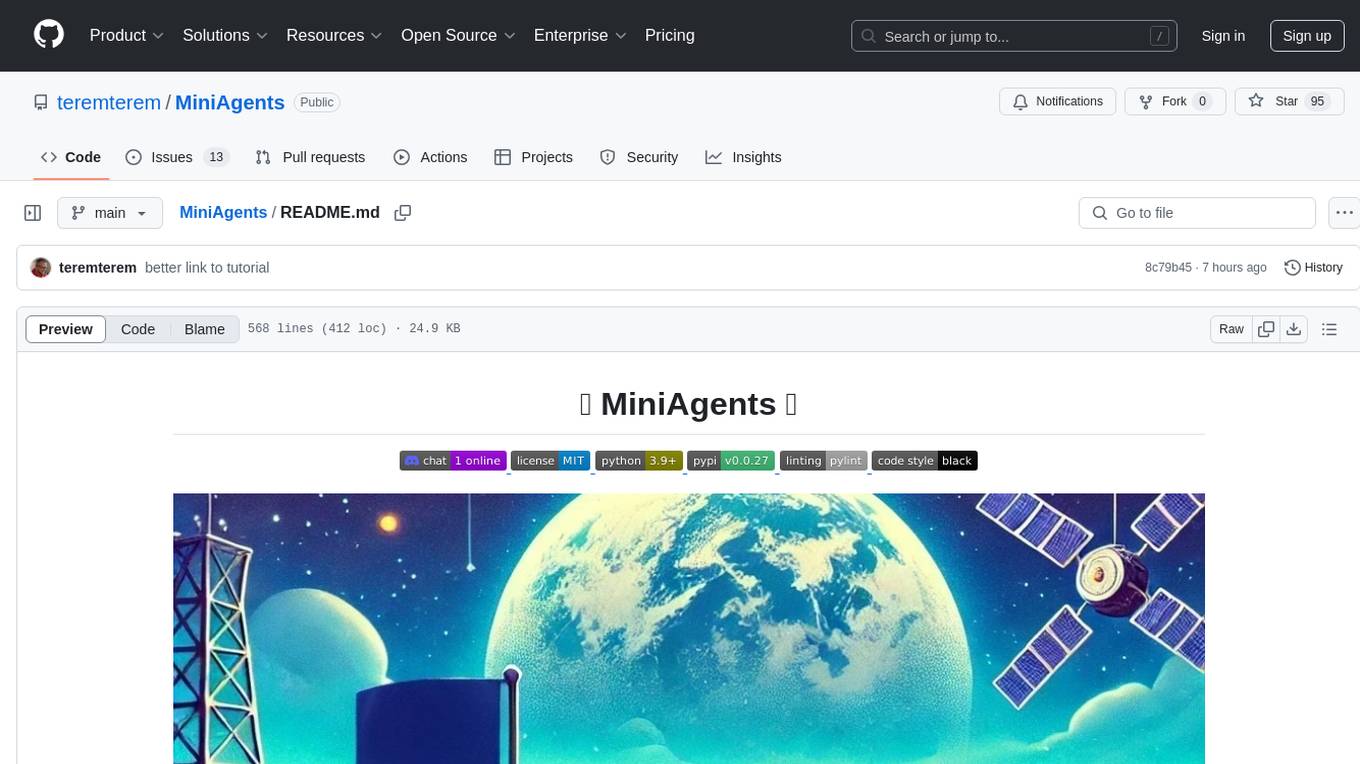
MiniAgents
MiniAgents is an open-source Python framework designed to simplify the creation of multi-agent AI systems. It offers a parallelism and async-first design, allowing users to focus on building intelligent agents while handling concurrency challenges. The framework, built on asyncio, supports LLM-based applications with immutable messages and seamless asynchronous token and message streaming between agents.
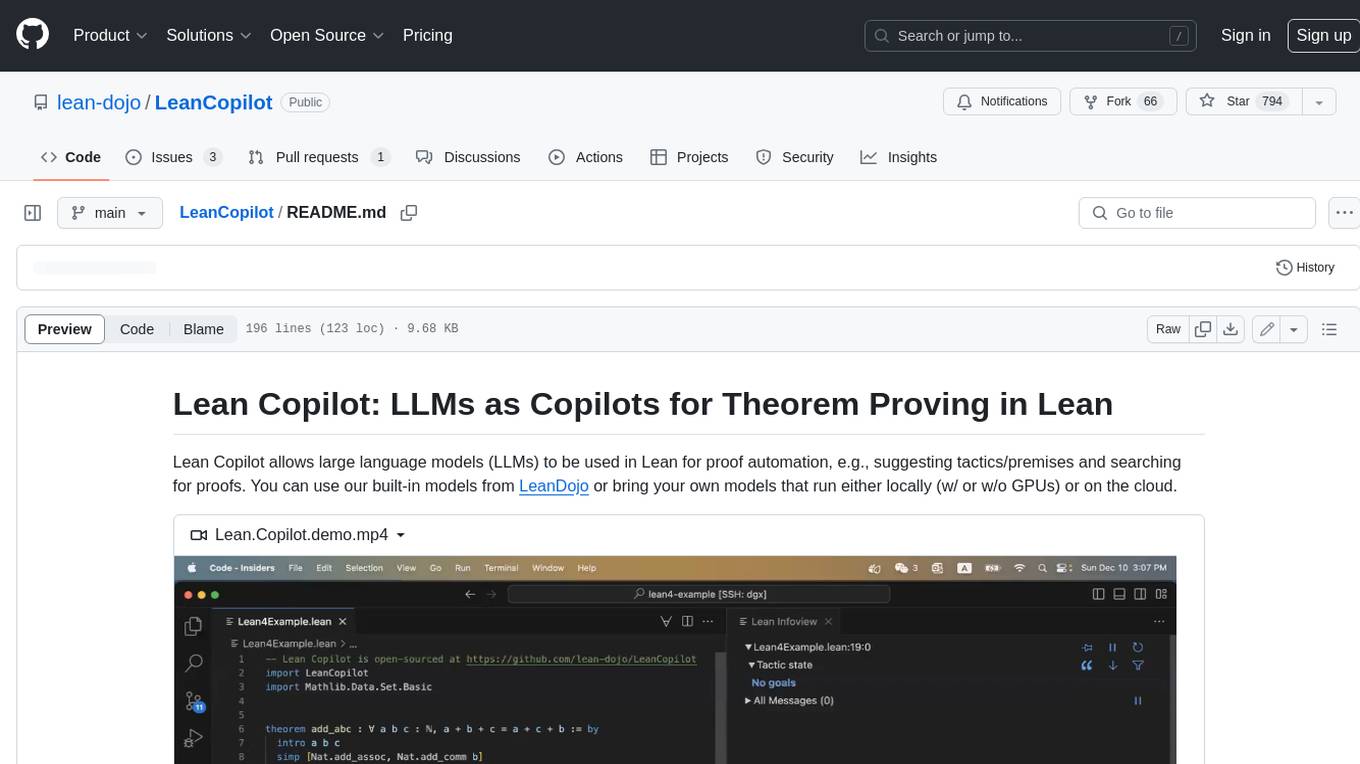
LeanCopilot
Lean Copilot is a tool that enables the use of large language models (LLMs) in Lean for proof automation. It provides features such as suggesting tactics/premises, searching for proofs, and running inference of LLMs. Users can utilize built-in models from LeanDojo or bring their own models to run locally or on the cloud. The tool supports platforms like Linux, macOS, and Windows WSL, with optional CUDA and cuDNN for GPU acceleration. Advanced users can customize behavior using Tactic APIs and Model APIs. Lean Copilot also allows users to bring their own models through ExternalGenerator or ExternalEncoder. The tool comes with caveats such as occasional crashes and issues with premise selection and proof search. Users can get in touch through GitHub Discussions for questions, bug reports, feature requests, and suggestions. The tool is designed to enhance theorem proving in Lean using LLMs.
For similar tasks

x-lstm
This repository contains an unofficial implementation of the xLSTM model introduced in Beck et al. (2024). It serves as a didactic tool to explain the details of a modern Long-Short Term Memory model with competitive performance against Transformers or State-Space models. The repository also includes a Lightning-based implementation of a basic LLM for multi-GPU training. It provides modules for scalar-LSTM and matrix-LSTM, as well as an xLSTM LLM built using Pytorch Lightning for easy training on multi-GPUs.
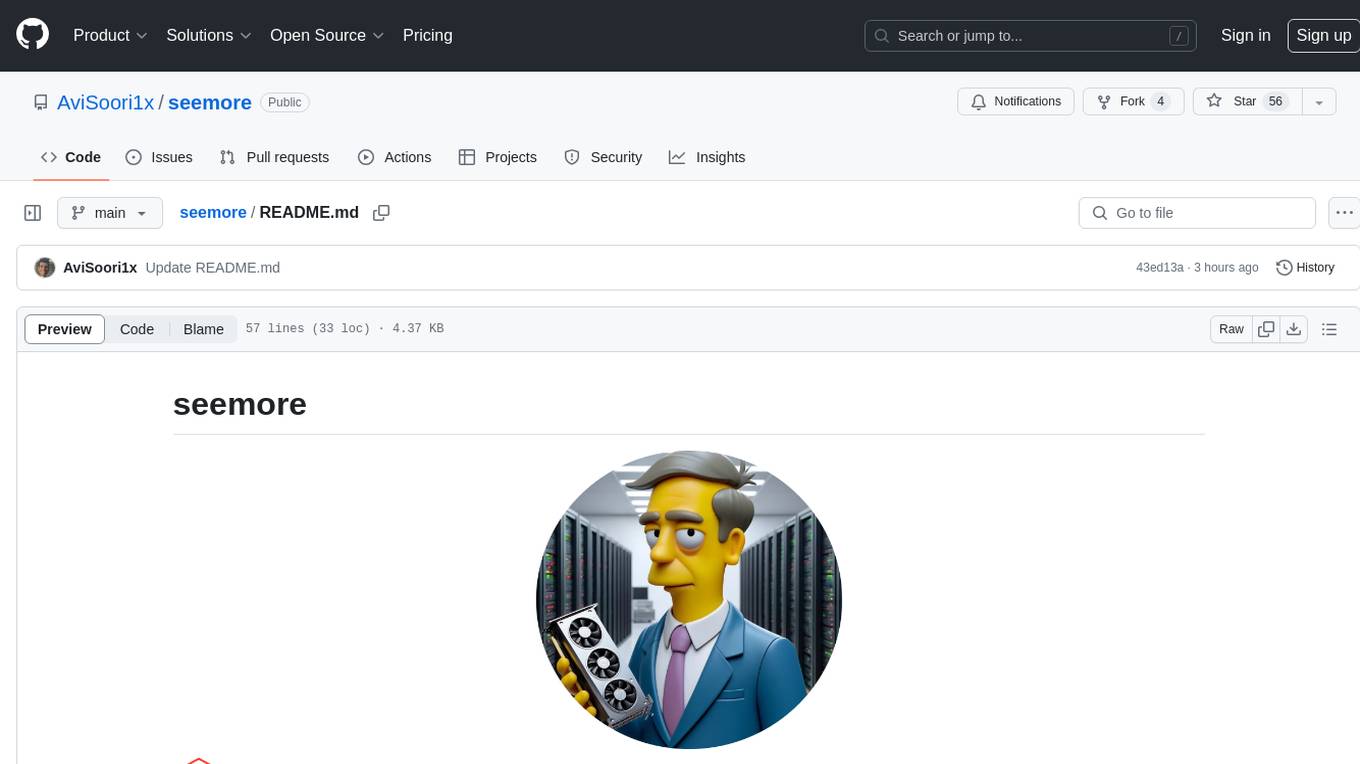
seemore
seemore is a vision language model developed in Pytorch, implementing components like image encoder, vision-language projector, and decoder language model. The model is built from scratch, including attention mechanisms and patch creation. It is designed for readability and hackability, with the intention to be improved upon. The implementation is based on public publications and borrows attention mechanism from makemore by Andrej Kapathy. The code was developed on Databricks using a single A100 for compute, and MLFlow is used for tracking metrics. The tool aims to provide a simplistic version of vision language models like Grok 1.5/GPT-4 Vision, suitable for experimentation and learning.
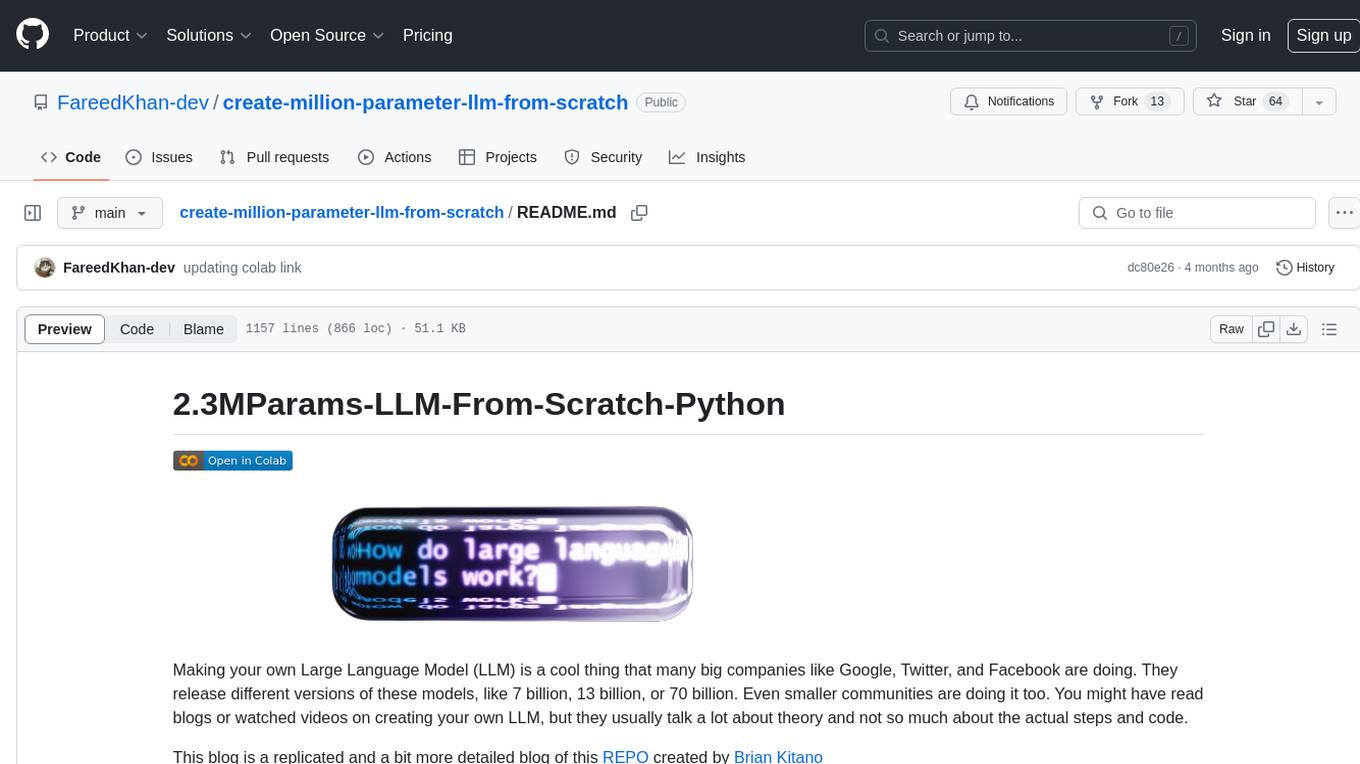
create-million-parameter-llm-from-scratch
The 'create-million-parameter-llm-from-scratch' repository provides a detailed guide on creating a Large Language Model (LLM) with 2.3 million parameters from scratch. The blog replicates the LLaMA approach, incorporating concepts like RMSNorm for pre-normalization, SwiGLU activation function, and Rotary Embeddings. The model is trained on a basic dataset to demonstrate the ease of creating a million-parameter LLM without the need for a high-end GPU.
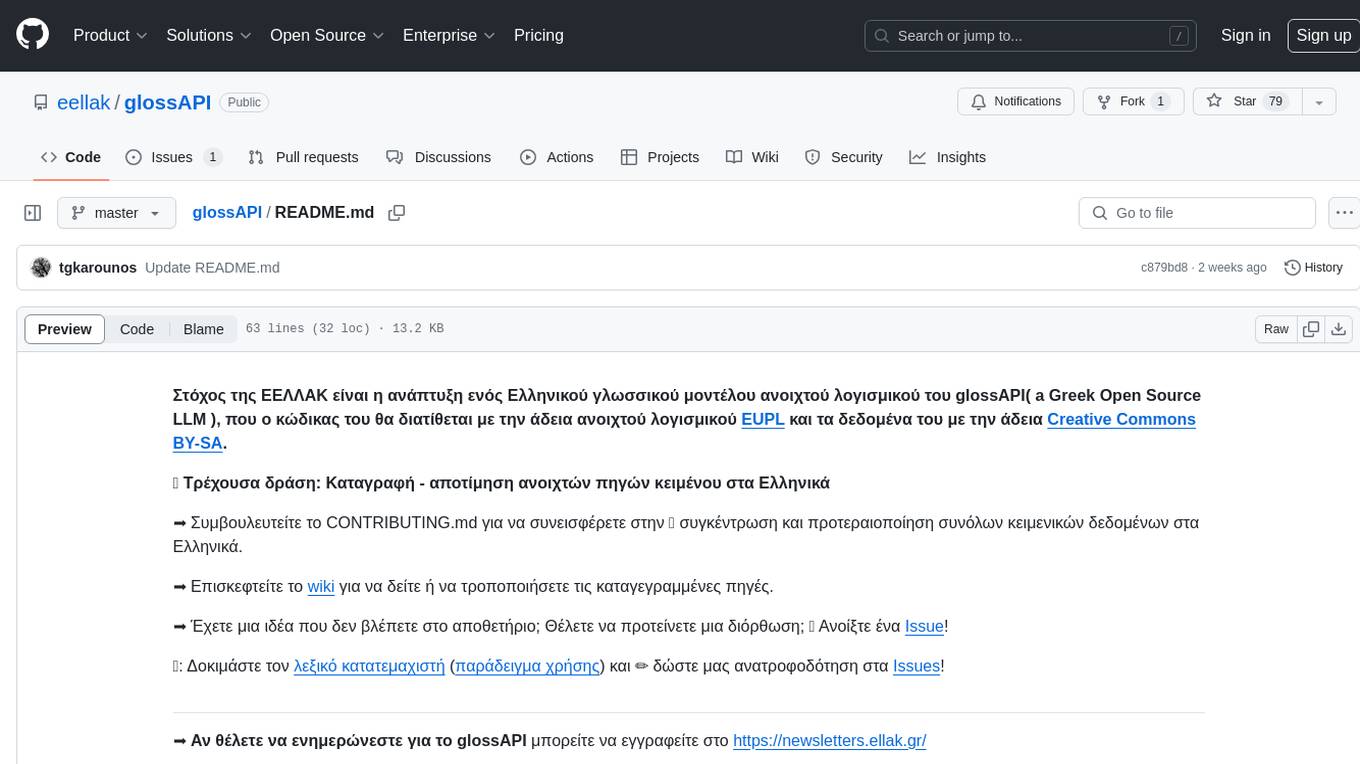
glossAPI
The glossAPI project aims to develop a Greek language model as open-source software, with code licensed under EUPL and data under Creative Commons BY-SA. The project focuses on collecting and evaluating open text sources in Greek, with efforts to prioritize and gather textual data sets. The project encourages contributions through the CONTRIBUTING.md file and provides resources in the wiki for viewing and modifying recorded sources. It also welcomes ideas and corrections through issue submissions. The project emphasizes the importance of open standards, ethically secured data, privacy protection, and addressing digital divides in the context of artificial intelligence and advanced language technologies.
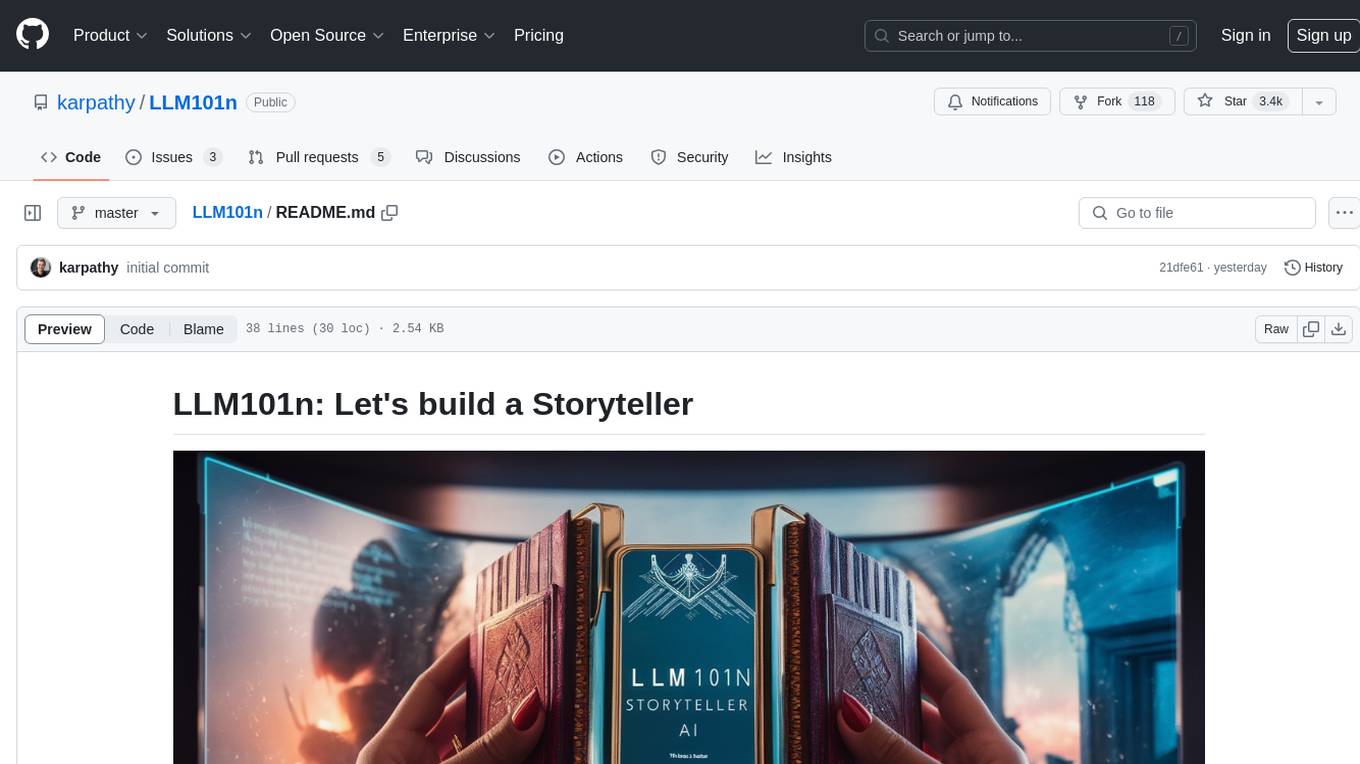
LLM101n
LLM101n is a course focused on building a Storyteller AI Large Language Model (LLM) from scratch in Python, C, and CUDA. The course covers various topics such as language modeling, machine learning, attention mechanisms, tokenization, optimization, device usage, precision training, distributed optimization, datasets, inference, finetuning, deployment, and multimodal applications. Participants will gain a deep understanding of AI, LLMs, and deep learning through hands-on projects and practical examples.
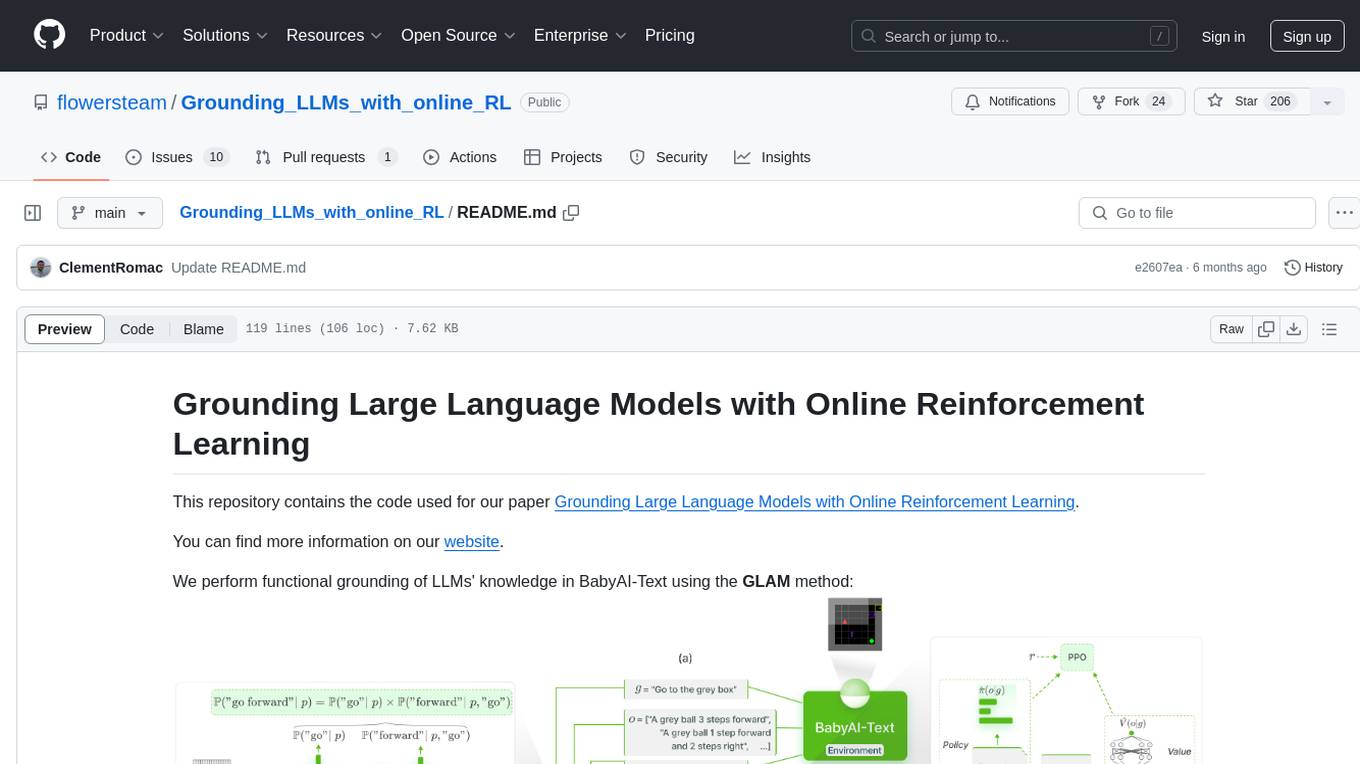
Grounding_LLMs_with_online_RL
This repository contains code for grounding large language models' knowledge in BabyAI-Text using the GLAM method. It includes the BabyAI-Text environment, code for experiments, and training agents. The repository is structured with folders for the environment, experiments, agents, configurations, SLURM scripts, and training scripts. Installation steps involve creating a conda environment, installing PyTorch, required packages, BabyAI-Text, and Lamorel. The launch process involves using Lamorel with configs and training scripts. Users can train a language model and evaluate performance on test episodes using provided scripts and config entries.
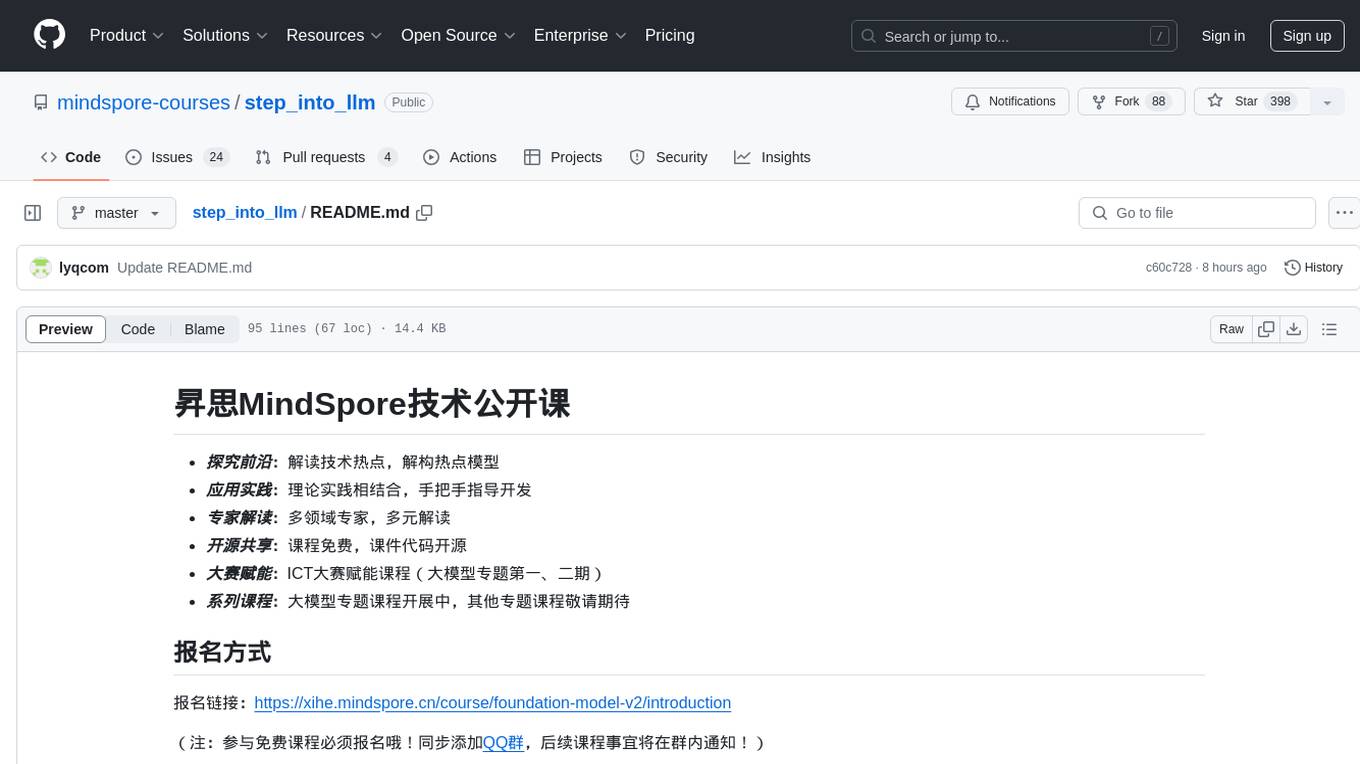
step_into_llm
The 'step_into_llm' repository is dedicated to the 昇思MindSpore technology open class, which focuses on exploring cutting-edge technologies, combining theory with practical applications, expert interpretations, open sharing, and empowering competitions. The repository contains course materials, including slides and code, for the ongoing second phase of the course. It covers various topics related to large language models (LLMs) such as Transformer, BERT, GPT, GPT2, and more. The course aims to guide developers interested in LLMs from theory to practical implementation, with a special emphasis on the development and application of large models.
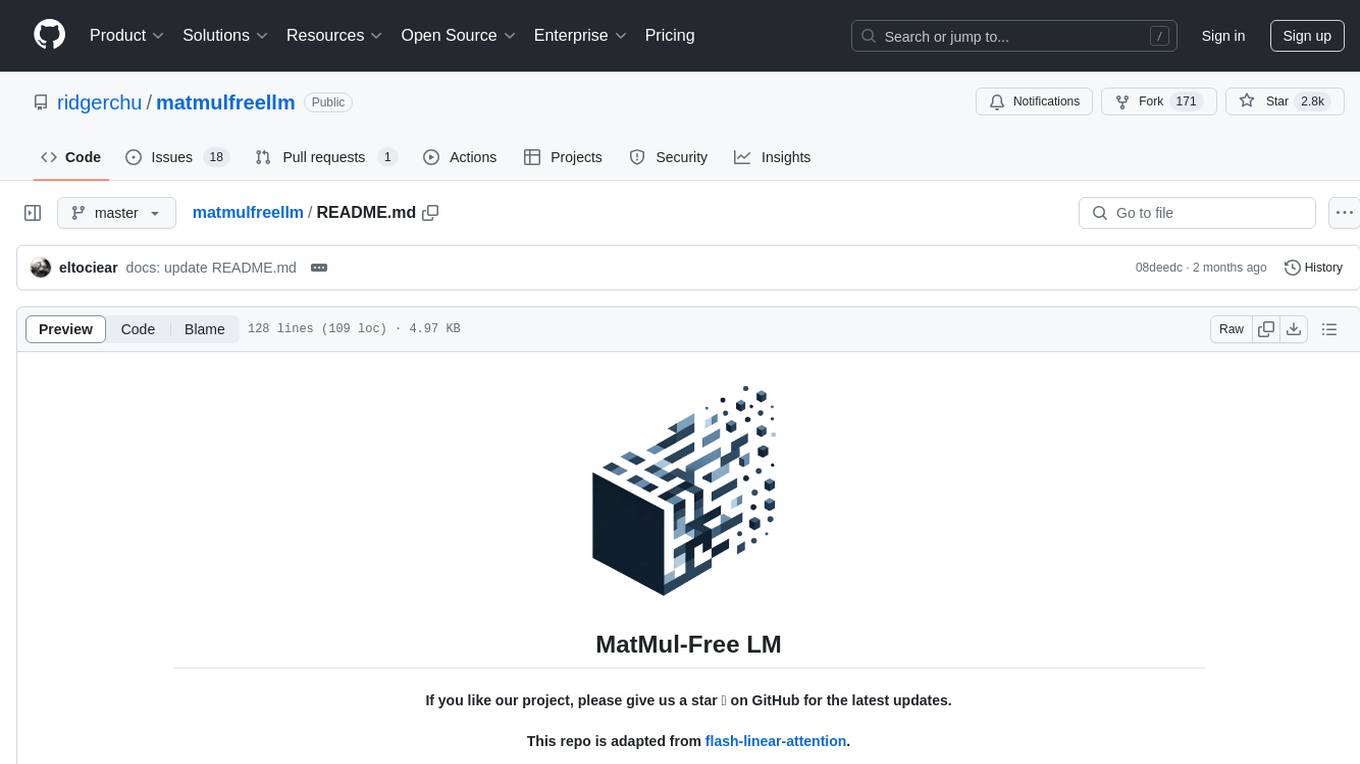
matmulfreellm
MatMul-Free LM is a language model architecture that eliminates the need for Matrix Multiplication (MatMul) operations. This repository provides an implementation of MatMul-Free LM that is compatible with the 🤗 Transformers library. It evaluates how the scaling law fits to different parameter models and compares the efficiency of the architecture in leveraging additional compute to improve performance. The repo includes pre-trained models, model implementations compatible with 🤗 Transformers library, and generation examples for text using the 🤗 text generation APIs.
For similar jobs

sweep
Sweep is an AI junior developer that turns bugs and feature requests into code changes. It automatically handles developer experience improvements like adding type hints and improving test coverage.

teams-ai
The Teams AI Library is a software development kit (SDK) that helps developers create bots that can interact with Teams and Microsoft 365 applications. It is built on top of the Bot Framework SDK and simplifies the process of developing bots that interact with Teams' artificial intelligence capabilities. The SDK is available for JavaScript/TypeScript, .NET, and Python.

ai-guide
This guide is dedicated to Large Language Models (LLMs) that you can run on your home computer. It assumes your PC is a lower-end, non-gaming setup.

classifai
Supercharge WordPress Content Workflows and Engagement with Artificial Intelligence. Tap into leading cloud-based services like OpenAI, Microsoft Azure AI, Google Gemini and IBM Watson to augment your WordPress-powered websites. Publish content faster while improving SEO performance and increasing audience engagement. ClassifAI integrates Artificial Intelligence and Machine Learning technologies to lighten your workload and eliminate tedious tasks, giving you more time to create original content that matters.

chatbot-ui
Chatbot UI is an open-source AI chat app that allows users to create and deploy their own AI chatbots. It is easy to use and can be customized to fit any need. Chatbot UI is perfect for businesses, developers, and anyone who wants to create a chatbot.

BricksLLM
BricksLLM is a cloud native AI gateway written in Go. Currently, it provides native support for OpenAI, Anthropic, Azure OpenAI and vLLM. BricksLLM aims to provide enterprise level infrastructure that can power any LLM production use cases. Here are some use cases for BricksLLM: * Set LLM usage limits for users on different pricing tiers * Track LLM usage on a per user and per organization basis * Block or redact requests containing PIIs * Improve LLM reliability with failovers, retries and caching * Distribute API keys with rate limits and cost limits for internal development/production use cases * Distribute API keys with rate limits and cost limits for students

uAgents
uAgents is a Python library developed by Fetch.ai that allows for the creation of autonomous AI agents. These agents can perform various tasks on a schedule or take action on various events. uAgents are easy to create and manage, and they are connected to a fast-growing network of other uAgents. They are also secure, with cryptographically secured messages and wallets.

griptape
Griptape is a modular Python framework for building AI-powered applications that securely connect to your enterprise data and APIs. It offers developers the ability to maintain control and flexibility at every step. Griptape's core components include Structures (Agents, Pipelines, and Workflows), Tasks, Tools, Memory (Conversation Memory, Task Memory, and Meta Memory), Drivers (Prompt and Embedding Drivers, Vector Store Drivers, Image Generation Drivers, Image Query Drivers, SQL Drivers, Web Scraper Drivers, and Conversation Memory Drivers), Engines (Query Engines, Extraction Engines, Summary Engines, Image Generation Engines, and Image Query Engines), and additional components (Rulesets, Loaders, Artifacts, Chunkers, and Tokenizers). Griptape enables developers to create AI-powered applications with ease and efficiency.
